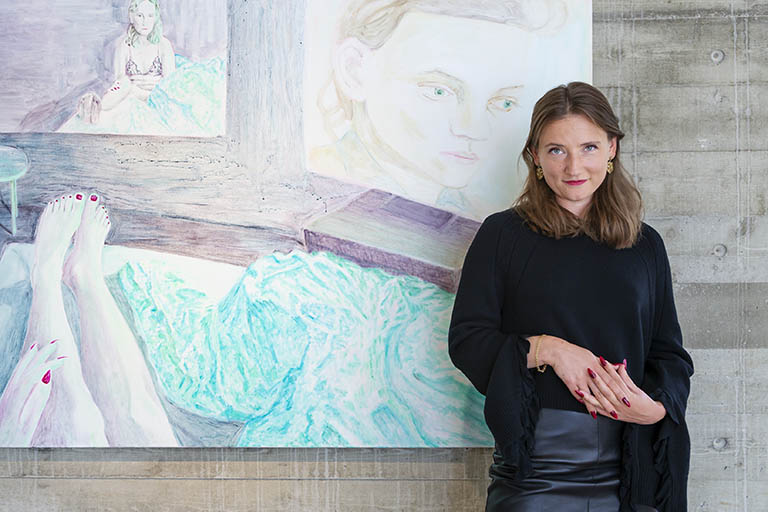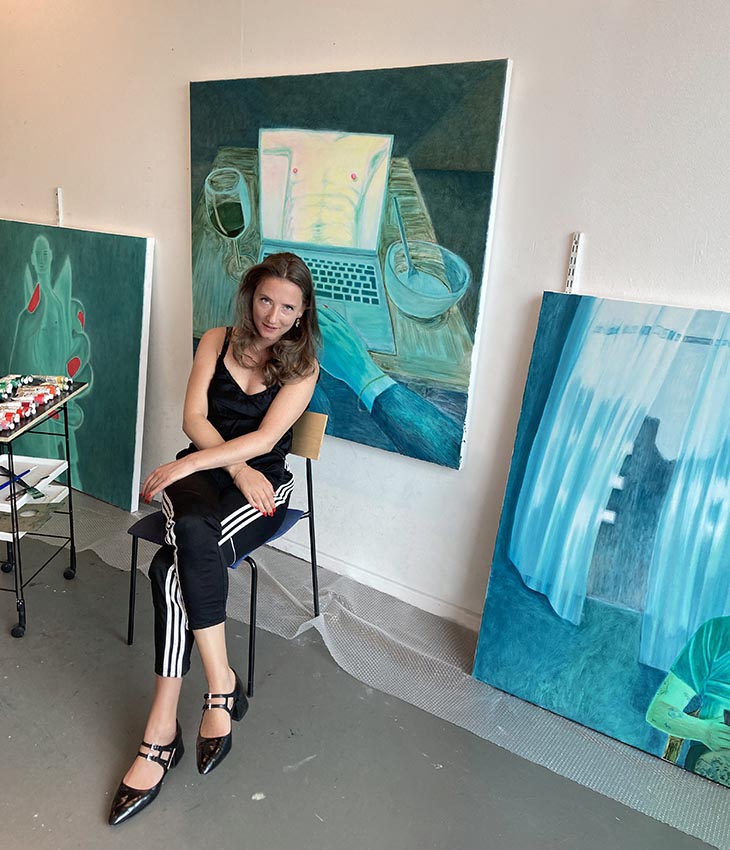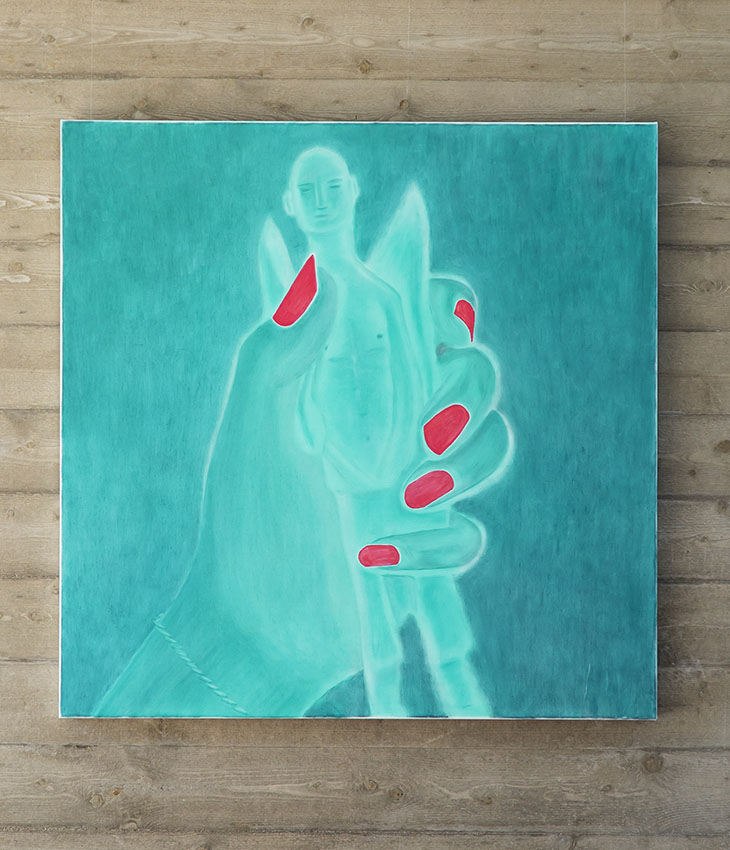Fredrik Roos Art Grant of 2022 – Judit Kristensen
Past exhibition April 27 – May 29, 2022
Between Wednesday April 27 and Sunday May 29 Artipelag exhibits art by Judit Kristensen, recipient of the Fredrik Roos Art Grant of 2022.

The art grant is awarded to Judit Kristensen with the following motivation:
”Judit Kristensen’s paintings inevitably provoke thoughts of the pandemic that has ravaged the world during the last two years. However, her paintings are not infused with the sense of desperate loneliness that has characterised this troubled time. On the contrary, Judit Kristensen’s paintings are distinguished by a coldness that lends them an almost observing and analytical character. Which is perhaps not surprising when one learns that Judit Kristensen, before she embarked on her artistic education, trained as a psychologist at Umeå University. Her almost clinical manner of relating to these emotional states bear witness to a deep understanding of the human psyche.”
2022 is the fifth year the award and exhibition take place at Artipelag.


More information
During the emergence of modern art there were few art academies in Sweden. The most important ones were the Royal Institute of Art and the University of Arts, Crafts and Design (Konstfack) in Stockholm and the Valand Academy in Gothenburg. At the time, it was possible to identify an artist’s style according to the education they had received. In somewhat simplified terms, Stockholm was focused on form while Gothenburg put the emphasis on colour, which resulted in the School of the Gothenburg Colourists. Needless to say, this is a broad generalisation but nevertheless, there is some truth in the assertion that the professors of the academies served as important role models for the students. One still employs epithets such as “a student of Endre Nemes” or “a student of Ragnar Sandberg” as a stamp of quality.
Today, however, the situation is different. The number of art academies has increased to include Umeå and Malmö and the art scene has expanded globally. It is no longer possible to identify an artist as a student of a specific academy and it is even harder to relate an artist to a specific professor.
Judit Kristensen received her artistic education at the Academy of Fine Arts, Umeå, where she obtained her master’s degree in 2021. It is not easy to identify traces from the Umeå Academy in her work and even harder to discern any professorial influence. In other words, Judit Kristensen appears as a highly individual artist with no attachment to the site of her training. In fact, her artistic practice does not even feel Swedish. It is almost as if she could have sprung from anywhere in the Western world. It would be interesting to know if her painting changed after she moved from Umeå to Antwerp. I suspect not. And the reason for that may quite simply be because her paintings are not primarily representations of a physical reality but rather more depictions of emotional states.
The subject matter of Judit Kristensen’s paintings are interior spaces. Not excessively well composed, they rather look as if they were episodic glimpses of an almost random nature. The spaces appear flattened out by a yellow-green artificial light, originating not from natural sources but from computer or television screens, which infuses the pictorial space with an unreal gleam. These flat spatial constructions feature a number of contemporary quotidian objects, such as computers, Coca-Cola bottles, television screens, in brief, objects whose appearance is more or less identical wherever they appear. Neither is the character of the objects particularly painterly, when contrasted with paintings of older still lifes that tested the skills of painters and presented a challenge to the viewer, who had to interpret the objects and organise them into a comprehensive iconography that encompassed both the contemplative and the ethical. Producing a symbolic interpretation of the objects that occur in Judit Kristensen’s paintings presents a formidable challenge. Appearing to be everyday objects devoid of metaphysical dimensions, they accentuate the feeling of loneliness in front of a screen that seems to be the only port of communication with the exterior world.
Judit Kristensen’s paintings inevitably provoke thoughts of the pandemic that has ravaged the world during the last two years. However, her paintings are not infused with the sense of desperate loneliness that has characterised this troubled time. On the contrary, Judit Kristensen’s paintings are distinguished by a coldness that lends them an almost observing and analytical character. Which is perhaps not surprising when one learns that Judit Kristensen, before she embarked on her artistic education, trained as a psychologist at Umeå University. Her almost clinical manner of relating to these emotional states bear witness to a deep understanding of the human psyche. It is with great pleasure that we congratulate Judit Kristensen on the 2022 Fredrik Roos Art Grant and welcome her to Artipelag.
Fredrik Roos (born 1951, died 1991) was a financier and art collector from Sweden’s southernmost province of Scania. In 1988, he founded the Rooseum – Center for Contemporary Art in Malmö, home to international exhibitions and Fredrik Roos’s collection of contemporary Nordic art. The museum closed in 2006 and 60 artworks from the collection were sold. This money was used to set up The Fredrik Roos Foundation.
The recipient of the scholarship should be “an artist who – in the spirit of Fredrik Roos himself – is prepared to take risks in their artistry. One who believes in themself and who has their own unique expression. The artist should be no more than 35 years old, come from a Nordic country, and preferably work with painting and/or sculpture”.
The foundation has a close collaboration with Sweden’s five art schools. Since 2019 the foundation has also opened up for artists working in Denmark, Finland, Iceland and Norway.
The foundation’s homepage >> (in Swedish only)
2021 Gabriel Karlsson (exhibition at Artipelag)
2020 Siri Elfhag (exhibition at Artipelag)
2019 Sara Nielsen Bonde (exhibition at Artipelag)
2018 Jonas Malmberg (exhibition at Artipelag)
2017 Oskar Hult, Josefine Östberg Olsson and Jonas Silfversten Bergman
2016 Sandra Mujinga, André Talborn and Karl Patric Näsman
2015 Martha Ossowska Persson, Idun Baltzersen and Ida Persson
2014 Tomas Lundgren
2013 Paul Fägerskiöld